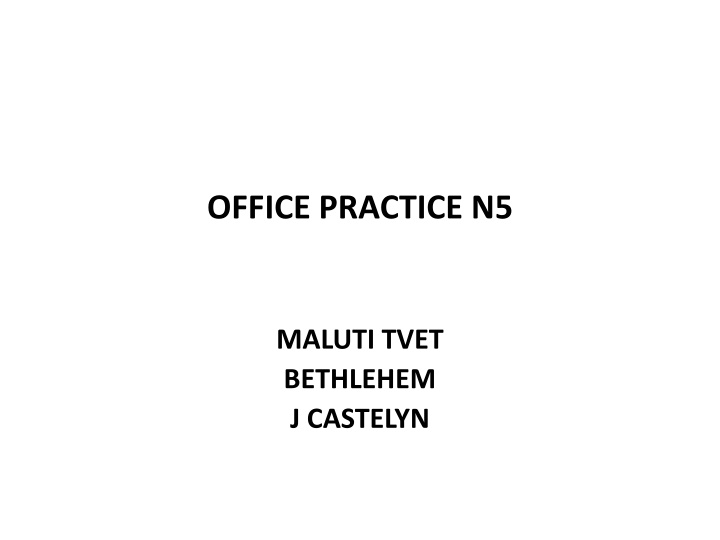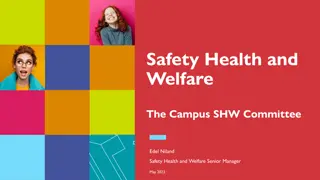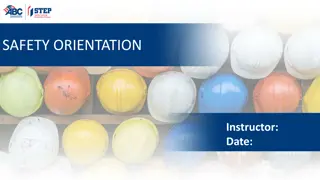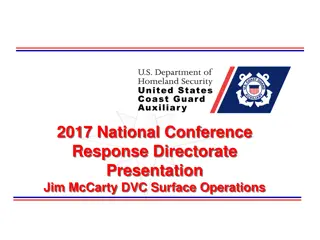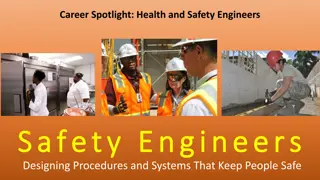Safety Guidelines for Office Environments
Guidelines for ensuring safety in office environments include developing occupational health and safety policies, implementing reporting systems, ensuring safe equipment operations, emphasizing ergonomic considerations, and maintaining clear access routes and internal traffic flow. Reference the Occupational Health and Safety Act and occupational health and safety manuals to promote a safe and secure work environment.
Download Presentation

Please find below an Image/Link to download the presentation.
The content on the website is provided AS IS for your information and personal use only. It may not be sold, licensed, or shared on other websites without obtaining consent from the author.If you encounter any issues during the download, it is possible that the publisher has removed the file from their server.
You are allowed to download the files provided on this website for personal or commercial use, subject to the condition that they are used lawfully. All files are the property of their respective owners.
The content on the website is provided AS IS for your information and personal use only. It may not be sold, licensed, or shared on other websites without obtaining consent from the author.
E N D
Presentation Transcript
OFFICE PRACTICE N5 MALUTI TVET BETHLEHEM J CASTELYN
TOPIC 4: ACCESS CONTROL, SECURITY AND SAFETY 6. GUIDELINES TO ENSURE SAFETY IN THE OFFICE
6. GUIDELINES TO ENSURE SAFETY IN THE OFFICE 6.1 GUIDELINES FOR SAFETY IN THE OFFICE. -(OHS ACT)- 6.1.1 LEGISLATION REGARDING OFFICES 6.1.2 UNSAFE CONDITIONS 6.1.3 UNSAFE ACTIONS
6. GUIDELINES TO ENSURE SAFETY IN THE OFFICE 6.2 PROCEDURAL MANUAL FOR USE BY OFFICE STAFF. 6.2.1 BOMB THREAT 6.2.2 FIRE 6.2.3 HOSTAGE SITUATION 6.2.4 ARMED ROBBERY 6.2.5 BASIC FIRST AID
6.2.5 BASIC FIRST AID: 1. 2. 3. 4. 5. 6. 7. 8. SHOCK SEMI-CONSIOUSNESS/UNCONSIOUSNESS BREATHING FAINTING WOUNDS BLEEDING BURNS ANXIETY /PANICK ATTACKS - OP N4 BASIC FIRST AID: - 1. 2. 3. 4. 5. HEART ATTACK STROKE EPILEPSY FRACTURES ASTHMA etc.
6. GUIDELINES TO ENSURE SAFETY IN THE OFFICE Two documents determines safety and security in the office: THE OCCUPATIONAL HEALTH AND SAFETY ACT (No.85 of 1993) or OHS Act. OCCUPATIONAL HEALTH AND SAFETY MANUAL /POLICY OF THE BUSINESS ITSELF
6.1 GUIDELINES TO ENSURE SAFETY IN THE OFFICE ALWAYS REFER WHEN DOING CASE STUDIES: Policy: Occupational health and safety policy be developed and made available to staff members. To be included Reporting system: A system for reporting occupational health and safety risks must be introduction. Prompt recognition, reporting and remedial action is important. Safe operations of equipment: When operating equipment ensure safeguards are in position. Staff should be adequately trained. Do not fix problems yourself if not been trained to do so. Operation manuals: All equipment must be issued along with a user manual and available to staff working with equipment to prevent unsafe operations. Ergonomics: Refer to the best fit between humans and their work environment. The equipment must fit the user. Refers temperature control and ventilation, noise, good lighting. Conditions that may cause repetitive strain injuries must be avoided / minimised.
6.1 GUIDELINES TO ENSURE SAFETY IN THE OFFICE ALWAYS REFER WHEN DOING CASE STUDIES: Access routes: Must be clearly marked. Routes must be free of obstacles and fire doors be kept next to the fire doors. Escape doors must not be barred. Correct lifting of goods: Correct posture to be used when transport or transfer goods / equipment to prevent potentially dangerous situations or injury. Internal traffic: Passages/ hallways be spacious, well-lit and ventilated and to be used for additional storage space. Movement of staff must be safe where numbers of staff gather at entrances. Pathways be wheelchair friendly. Cleaning and hygiene: To ensure healthy working conditions, but not creating additional risks. A healthy environment includes proper hygiene processes to be followed. Rodent control is important. The must ensure equipment is maintained. Threats: People who are stressed, struggle with self-control and pose a potential threat to their colleagues. People roaming around a business trying to gain access to buildings and offices and must be reported to security. Relaxation areas: Staff must have access to areas to relax or take a break from the workstation without interruption in order to socialise and build good relationships for short intervals.
6.1.1 LEGISLATION PERTAINING TO OFFICES The OHS Act (No 85 of 1993) is the basis document to guide safety in the office. Purpose of the Act is to set guidelines for the improvement of the working environment and working conditions, in order to maintain the working capacity and health of employees. The focus is on preventing accidents and eliminating hazards in the workplace. For every 20 employees employed there must be a health and safety officer in place. The Act stipulates details around the operations of health and safety committees and steps a business must put in place to adhere to the regulations of the Act. Breach of regulations can result in legal prosecution. Each employee must be allowed a clear floor space of 2,25m . An employer must provide adequate ventilation to employees in the workplace. Workers who are exposed to certain processes and substances must be provided with protective clothing.
6.1.1 LEGISLATION PERTAINING TO OFFICES An employer of more than five people must provide a satisfactory equipped first- aid box. For every 100 workers an additional first-aid box and first-aid room must be provided. Adequate means of escape in case of fire must be provided. All doors serving as exists must be kept clear and unfastened during working hours to allow quick and easy evacuation. Adequate lighting must be provided. All dangerous machinery must be securely fenced and guarded unless impossible to do so. Special regulations apply to hoists, lifts and cranes, which must be regularly examined and not used to carry dangerous loads. Smoking and the use of open lights are prohibited in areas where there is a danger of fire. Suitable goggles/face shields must be supplied to every worker exposed to glare or to the danger of something getting into their eyes.
DEFINITIONS: UNSAFE CONDITIONS: Any environment, context, circumstance or situation that holds the potential for an accident to occur. OR Conditions created by the layout of the office which may create an unsafe condition. UNSAFE ACTS: Actions people take that cause unsafe situations and harm others, sometimes accidentally and often due to negligence. OR Conditions seen as accidents caused by human factor.
6.1.2 UNSAFE CONDITIONS Loose carpeting/ loose or broken tiles causing people to stumble and fall. High gloss / wet tiles or floors / air conditioning that drips on tiles make floor surfaces slippery. Items / boxes stacked on top of each other against walls or on top of filing cabinets / overloaded filing cabinets that can topple over. Open electrical cables or electrical cables running underneath carpets. Overloading of power points and the use of faulty appliances. Kettles, microwaves etc. can cause an electrical shock and fire. Electrical switches must work properly. Poor ventilation or air conditioning units that do not function properly cause fluctuation in humidity and temperature Incorrect placement of desks and/or computer can create continuous glare. Staff not adequately trained on First Aid, lack of First Aid kit. Lack of safety and evacuation plans and fire drills. Lack of smoke detectors.
6.1.2 UNSAFE CONDITIONS Furniture or trash placed near/ in walkways / passages where people can bump into it. Sharp edges and overloaded equipment can cause serious injuries. Doors open into passages can cause someone being knocked over if the door is opened suddenly. Inadequate lighting creates areas in walkways, passages or next to lifts that are poorly lit. Incorrect placement of desks creating glare, not adequate first aid training, lack of evacuation plans, lack of smoke detectors. The alarm and intercom system must be operational and portable fire extinguishers that are charged, must be secured and easily accessible. Desks and file drawers must be closed after use. Any item higher than 1,5m must be secured to the wall to prevent it from toppling over. Lack of OHS committee and adhering to the Act.
6.1.3 UNSAFE ACTIONS CAUSES: Employees ignoring safety procedures. Employees taking shortcuts to try and be more efficient . Not having complete instructions before starting a task. Being mentally distracted and unfocused and insufficient pre-planning. Not thinking through a process to complete a task before starting.
6.1.3UNSAFE ACTIONS Misuse of chairs: Standing on chair using it as a ladder /tilting in a chair/ sitting down without checking/ leaning sideways to reach something Poor handling of stationary: not using safety guards and getting finger cuts. Using wrong office equipment for the job./ misuse of office equipment Walk and chatting / holding sharp objects (not focused) / carrying stacked objects obscuring your vision. Negligence when using filing cabinets: overloading, open drawers, closing drawers with floor, over-stacking shelves Negligent use of electrical equipment and connections: overloading plugs, not switching power supply off before removing it, incorrect handling of equipment, using faulty equipment. Faulty wiring / cabling not fixed to walls, not trained /authorised to use. Computer related risks caused by operators: failure to take regular breaks, incorrect sitting/standing position, poor or awkward body posture, sitting to close to computer screens.
6.1.3 UNSAFE ACTIONS Wrong or quick movements: running, walking fast carrying hot and dangerous substances, wrong posture lifting heavy goods, carry too much, carrying unsealed substances Eating and drinking at workstation and not in staff room. Ignoring safety instructions, warnings and signage. Working without safety gear. Fooling around in the workplace. Overcrowding areas like staircases, walkways, elevators, corridors. Tampering with machinery or equipment or trying to fix it yourself.
6.2 PROCEDURAL MANUAL FOR USE BY OFFICE STAFF. AIM: To have a checklist or set of guidelines of what to do in an emergency situation. The manual must be to the point. Issued to each staff member. Summarised into poster format. Displayed on a wall in each office, public gathering and passageway.
6.2.1 BOMB THREAT DEFINITION: A written or verbal threat to detonate an explosive in a building or on the premises with the specific intention to do harm, cause damage or destroy. PROCEDURE: Bomb threats are not a joke and be treated seriously and given immediate attention. Can be verbally via a telephone call to the office. listen carefully to the threat. Keep the caller as long as possible on the phone. Try to discern and write down everything they say Get as much information as possible - Voice, language, precise words, reasons, background noises, gender, use of codes/strange words, names of persons. Places likely to place bombs. Contact designated person to take the lead on what to do next. Contact the police and fire brigade. The designated person and management will decide together how to manage evacuation operation and where people will gather. Stay clear of windows during evacuation. Take into account the number of people to evacuate by gather a staff list and visitor register. Act on a discreet way by considering the following: location of fire extinguishers, valuables stored away safely, switching of electrical devices and lights, taking personal belongings with you, leave doors and windows open, no use of cell phones or to smoke, do a roll-call at gathering point. Do not inform the media about the bomb threat at this stage.
6.2.2 FIRE DEFINITION: A chemical reaction that result in the burning of combustible material ELEMENTS OF A FIRE: Combustible substances fuel, carton, alcohol, wood Oxygen Source/Cause of ignition heat, explosive, electricity, smoking, open flames TYPES / CLASSES OF FIRE and TYPES OF EXTINGHUISER: A - ordinary combustibles like wood, cloth, plastics WATER, DRY POWDER B - gasoline, solvents - FOAM C - electrical equipment DRY POWDER D - sodium-potassium DRY POWDER
6.2.2 FIRE PROCEDURE: Stay calm by knowing exactly what to do. Evacuate the building immediately and go to the assembly point. Do a roll-call to determine who is safe. Do not use lifts, only the fire escapes. Do not use entrances as emergency exits. Close doors and windows to cut off oxygen. Help all the disabled first. Get down on hands and knees and crawl along the floor. Use wet material to protect against flames and smoke inhalation. If your clothes catch fire, drop and roll on the floor/ground.
6.2.3 HOSTAGE SITUATION DEFINITION: A person is kept prisoner by another person until the demands of the suspect are met or the situation is resolved. PROCEDURE: The first few moments are crucial be cooperative and do what is demanded. Do not try to be a hero by confronting the suspect. Do not try to reason. Do as instructed. Be aware of your own emotional/ physical reactions. Try to control intense feelings. Do not panic. The suspect want to be understood and treated with respect. Do not be demanding. If the situation is lengthy, try to build common ground. Do not discuss political/religious views. Try to keep track of time, place, movements and sounds. Keep your head clear by doing mental exercises. Try to remember as much as possible about the suspect e.g. Clothing, mannerisms, accents and code words. Being a hostage is not a permanent situation. Keep faith, try to stay emotionally strong.
6.2.4 ARMED ROBBERY DEFINITION: Situation where one person terrifies others in order to take goods or property by force. BEFORE/ PRECAUTIONS FOR A POSSIBLE ROBBERY: (not happening yet) Train employees what to do. Know how to defuse violent situations. Emergency plans be in place and alarms installed and panic buttons to activate a silent alarm. More than one exit be available to exit quickly. Provide adequate lighting in offices, buildings nad parking areas at night. Appoint a designated person in advance, to secure areas and lock doors as the robbers leave.
6.2.4 ARMED ROBBERY DURING A ROBBERY: (happening) Don't try to be a hero. Try to keep everyone calm. Don t provoke the robber. Stay calm. Try to activate the alarm unobtrusively, only if unnoticed. Don t make sudden moves. Tell the robber if you have to move. Carry out every instruction, but nothing more. Observe the robbers without them noticing it. Memorise what you can see about the person. When they leave, make a mental not of the direction in which way they fled and what they stole.
6.2.4 ARMED ROBBERY AFTER A ROBBERY: Call the police. Call an ambulance if necessary. Inform the designated person responsible for safety and security and/or the manager. Lock all doors and ask everyone to stay where they are. Give emotional support to those needing counselling. Provide a special area where statement can be made. Do not contact the media. Do not reveal the amount or items taken. Do not touch anything for fingerprints to be taken.
6.2.5 BASIC FIRST AID GUIDELINES/ WAYS TO ASSIST : SHOCK: happens when there is not enough blood getting to the body s tissues causing a loss of oxygen to the brain and organs and not functioning properly. SEMI-UNCONSCIOUS/UNCONSCIOUSNESS: Assess the level of consciousness by checking the eyes and speech responsiveness. BREATHING: when the person is not breathing, but has a pulse, place them in a recovery position. FAINTING: a person loose consciousness for a brief period of time do to insufficient oxygenated blood flowing to the brain. WOUNDS: when a layer of skin is broken, making the body susceptible to germs BLEEDING: Refers to blood escaping from blood vessels. BURNS: the signs and symptoms of burns assist in the determination of the degree of burn. ANXIETY/PANICK ATTACKS: appears to be life threatening but are not. Resulting from continued high stress, unreal fears, unable to handle negative situations.
6.2.5 BASIC FIRST AID: PROCEDURES 2. SEMI-CONSIOUSNESS / UNCONSIOUSNESS 1. SHOCK Find the injury / illness causing the shock. Handle gently because the person might be in pain. Keep the person warm by putting a blanket/coat over him. Loosen tight clothing around the waist, chest and neck. Do not give anything to drink or eat. Only moistened the lips. Put the person in a comfortable /recovery position. Open the airway. Put the person in the recovery position. Loosen tight clothes clothing around the waist, chest and neck. Ongoing monitoring of breathing. When consciousness is decreasing, seek medical help immediately.
6.2.5 BASIC FIRST AID: PROCEDURES 3. BREATHING 4. FAINTING Lay the person down and raise their feet about 30cm. Otherwise make the person sit with the head lower than the shoulder. Fresh air is important open windows. Loosen tight clothing around the waist, chest and neck. Stay with the person until recovered or handed over to medical personnel. Open the mouth, checking for obstruction in the airway. Lift the chin forward with one hand while the forehead is pressed back with the other hand. Maintain this position throughout. Kneel down next to the person. Put your mouth over the injured person s mouth and breathe deeply into it. The chest should rise. Remove your mouth and let the injured person s chest fall. Continue to inflate the lungs if the chest does not rise. When breathing resumes, place the person in the recovery position and stop mouth-to-mouth resuscitation.
6.2.5 BASIC FIRST AID: PROCEDURES 6. 7. BURNS 5. WOUNDS/ BLEEDING: If the person is talking, its a good sign because the airway is clear. Severe bleeding: apply direct pressure to the wound immediately. Whilst still applying pressure to the wound, elevate it to reduce blood flow. Wide open wounds: first try to bring the edges together. Put the person at rest to reduce the blood flow. Place a sterile dressing on the wound whilst keeping direct pressure on the dressings. When under control check for other serious injuries. Ensure for adequate blood circulation below the injury. Put a bandage over the dressing. If the dressing becomes soaked with blood, do not remove it, but add another dressing. Immediately cool the burn by immersing it in cool water or pour cool water over it. Cool down the burn until pain is lessened reduces temperature of area, reduce blisters, swells. As soon as possible remove anything on the burns that is tight (jewellery/ clothing). If it is stuck, don t remove. As the pain lessens, cover the burn with lint-free, clean dressing, such as a piece of linen sheet. A good dressing won t stick if removed.
6.2.5 BASIC FIRST AID: PROCEDURES 8. ANXIETY /PANICK ATTACKS Get the person to a quiet place away from others. Help the person to calm down and regain self-control. Do not forcibly restrain the person or slap them in their face. Suggest to them that they looking better. Help the person to relax with breathing exercises: count to 4 whilst inhaling and 4 counts whilst exhaling. Speak to the person in a calm, reassuring voice. Stay with the person until medical help arrives.
INSIDE THE FIRST-AID KIT: Antiseptic Swabs Cotton wool Scissors Sterile gauze Bandages Roller bandages First aid dressings Adhesive strips Splints Disposable latex gloves CPR breathing pieces Tweezers
ASSESSING AN INJURED PERSON: SEE blood, skin colour, swelling, bruises HEAR groans, quality of speech SMELL alcohol on the breath/ gas fumes FEEL skin temperature, dampness TELL pain, thirst, nausea, dizziness, fear
